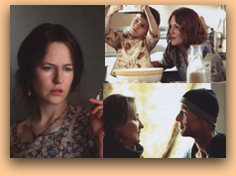
FEST2003
The Hours
Stephen Daldry, director
Review by Rada Djurica
"The Hours" is an Oscar voter's nightmare. It
is an adaptation of Michael Cunningham's novel about three women in three
different time periods whose lives are affected by Virginia Woolf's "Mrs.
Dalloway." Nicole Kidman finally won an Oscar for Best Actress for
the role of Virginia Woolf. Many people thought that she deserved an Oscar
for "Moulin Rouge" last year. Here, Nicole Kidman plays the
self-aware but psychologically unstable Woolf, at the time when she began
writing her most famous novel, while she was living a frustratingly quiet
life, supposedly for the sake of her mental health.
"The Hours" is a very ambitious piece of work. And it's full
of celebrities. Besides Nicole Kidman, we have Meryl Streep, who has the
largest number of Oscar nominations for acting awards, playing the role
of a gay woman struggling with depression. Her daughter is played by Claire
Danes.
Then, there is Julianne Moore, nominated for an Oscar for
Best Supporting Actress, who plays another alienated woman with a son
and a husband she doesn't love. Her friend is played by Toni Collete,
and John C. Reilly plays the unloved husband. Miranda Richardson is the
beloved sister of Virginia Woolf. And Ed Harris is the former lover of
Meryl Streep's character, living in Manhattan and dying of AIDS. "I
think I'm only staying alive to satisfy you," Harris says (who must
have lost at least 30 pounds for the role), who contemplates killing himself
and cutting off his last living hours.
This is one hell of a circle of human destinies, from three different
time periods. First, we have the life and death of Virginia Woolf, then
the time of a woman who doesn't loves her husband in the 1950s, and a
21st Century gay woman and her former male lover, who is dying of AIDS.
It all turns around Woolf's book "Mrs. Dalloway" and her problems
with depression and alienation in the 1920s. All three female profiles
are joined by their depression and by a common search for love.
The film begins with Virginia Woolf's suicide in England in the early 1920s. It keeps on flowing into the 1950s in a California suburb, with a woman (Julianne Moore) who struggles between her son and the husband she doesn't love but who adores her. We end up next in a modern Manhattan flat with Clarissa (Meryl Streep), who lives with her female lover and her daughter, and is preparing a party for her former lover (Ed Harris), who is dying of AIDS. They all struggle through the day, defined by themselves but equally defined by other people. Their struggle is central and very important. The women are externally serene, perfectionist party-throwers, hiding deep reservoirs of regret over missed opportunities in their lives.
"The Hours" is a triumph of emotionally and narratively
complex filmmaking. These women share literal and figurative parallels
with "Mrs. Dalloway" providing a thematic undercurrent that
inspires the film director to dare to go further. Daldry does a good job
of balancing the three stories. It sounds very complicated, but it is
actually very simple. They all identify with Virginia Woolf.
I just think that "The Hours" should have received an award
for makeup, because it is absolutely unbelievable how much Nicole Kiman
looks like Virginia Woolf. Kidman's manifestation goes literally right
down to her fingertips, from the movie's opening scene, set some 18 years
later, as she writes a suicide note.